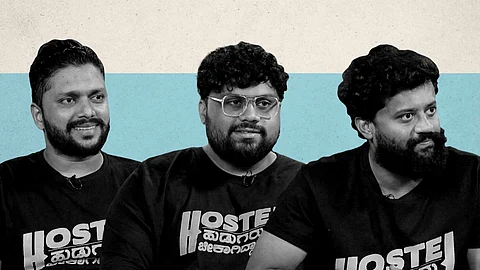
- Reviews
- Power List 2024
- Cannes 2024
- In-Depth Stories
- Web Stories
- News
- FC Lists
- Interviews
- Features
- FC SpecialsFC Specials

For the past two years, one film that has got the Kannada audience intrigued beyond measure is Hostel Hudugaru Bekagiddare. The team has been rolling out quirky promotional videos featuring some of the biggest stars in the industry, including Kichcha Sudeepa, Ramya and the late Puneeth Rajkumar. The film is also presented by Rakshit Shetty's Paramvah Studios. "Rakshit Shetty saw the film and immediately asked us if we wanted him to present the film," says Aravind Kashyap, the cinematographer of the film. "He saw the film thrice and he loved it," says director Nithin Krishnamurthy.
The film industry has a lion's share of campus comedies that bank on the nostalgia of student life, with Rakshit Shetty's Kirik Party being one of the most successful ones. But team HHB ensured they stand apart from other campus films with their quirky promo videos, featuring generous doses of self-deprecating humour, pop culture references and cameos by stars. "From the beginning, we were sure that we wanted to make a film completely with newcomers," says Nithin Krishnamurthy, "The reach that a film gets with a star attached is unparalleled. Since we knew that the film will star only newcomers, we thought we could approach stars for the marketing of the film and bring out a quirky side of them that suits the funny tone of the film."
"All the videos are related to the story," adds Aravind Kashyap, "The promo videos are relevant not just to the tone of the film but they also in some way or the other make it the final cut. There are references to them in the film."
"Puneeth sir was a bit hesitant at first," adds lead actor Prajwal when asked about how they convinced these stars to get in line with their humour, "He did not want to scold us and said that it might come across as negative publicity." Nithin adds, "He was right in a way as many people asked us later how did it feel to get scolded by Puneeth sir. But it was all part of the plan".
The trailer of the film, which was recently released, tells the story of a bunch of students. The film is shot in the cinema verite technique, which is a concept derived from a documentary style of filmmaking. "I would say the film is inspired by the cinema verite technique," says Nithin when asked about the style. "It is very hard to categorise the film into a single genre. A comedy, or a commercial film doesn't really do justice to it. Basically, the style of filmmaking is inspired by the verite technique, where scenes don't appear staged or blocked. We show it in a way as if it is being documented in real-time."
"One of the most important aspects of the cinema verite technique is that the cinematographer is part of the narrative," says Aravind. "The guy who is making the film is part of the film."
"We can call this film as a mix of cinema verite and the found-footage genre," adds Nithin. "The way found-footage works is they create a narrative as if someone has shot this and that the video has been found and they are now releasing it. You'll know when you see the film why such a description makes sense."
While it can be a challenge to stay committed to a project through a two-year-long production period, the makers claim that the film was planned to go on floors within six weeks of starting the project, without any kind of extensive pre-production. "Nithin just had a one-line of the story," says Prajwal, "We then had discussions and each one of us had something to say or depict as we had all lived through this phase. The screenplay developed like that."
Nithin goes on to add, "In fact, I would say the screenplay was only done after the shoot. We shot in Mangalore and since the film is mostly set in the night, we would have rehearsals all day and then shoot at night. We shot for about 100 days, mostly because we faced obstacles such as heavy rains. But we had an extensive cast, with at least 100 actors in some scenes. We auditioned around 7000 actors for the film and each of the ones we selected has a line. Our audio post-production took about 98 days because we had so many layers of dialogue."
Prajwal reiterates, "The process was very organic and without such a process I don't think we would have crafted such a product. It made sense to go with such a process which was in line with the cinema verite technique as well."